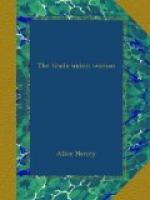The career of the Knights of Labor, however, as an active force in the community, began with the National Convention of 1878, from which time it made efforts to cover the wage-earning and farming classes, which had to constitute three-fourths of the membership. The organization was formed distinctly upon the industrial and not upon the craft plan. That is, instead of a local branch being confined to members of one trade, the plan was to include representatives of different trades and callings. That the fundamental interests of the wage-earner and the farmer were identical, was not so much stated as taken for granted. In defining eligibility for membership there were certain significant exceptions made; the following, being considered as pursuing distinctly antisocial occupations, were pointedly excluded: dealers in intoxicants, lawyers, bankers, stock-brokers and professional gamblers.
Women were first formally admitted to the order in September, 1881. It is said that Mrs. Terence V. Powderly, wife of the then Grand Master Workman, was the first to join. It is not known that any figures exist showing the number of women who at any one time belonged to the Knights of Labor, but Dr. Andrews estimates the number, about the year 1886, when the order was most influential, at about 50,000. Among this 50,000 were a great variety of trades, but shoe-workers must have predominated, and many of these had received their training in trade unionism among the Daughters of St. Crispin.
The Knights evidently took the view that the woman’s industrial problem must to a certain extent be handled apart from that of the men, and more important still, that it must be handled as a whole. This broad treatment of the subject was shown when at the convention of 1885 it was voted, on the motion of Miss Mary Hannafin, a saleswoman of Philadelphia, that a committee to collect statistics on women’s work be appointed. This committee consisted of Miss Hannafin and Miss Mary Stirling, also of Philadelphia, and Mrs. Lizzie H. Shute, of Haverhill, Massachusetts, who were the only women delegates to the Convention.
At the next convention, held in 1886 in Richmond, Virginia, there were sixteen women delegates, out of a total of six hundred. Mr. Terence V. Powderly, Grand Master Workman, appointed the sixteen women as a committee to receive and consider the report of this previously appointed special committee of three. The result of their deliberations was sufficiently remarkable. They set an example to their sex in taking the free and independent stand they did. For they announced that they had “formed a permanent organization, the object of which will be to investigate the abuses to which our sex is subjected by unscrupulous employers, to agitate the principle which our order teaches of equal pay for equal work and abolition of child labor.” They also recommended that the expenses of this new woman’s department and the expenses of a woman investigator should be borne by the order. The report was adopted and the memorable Woman’s Department of the Knights of Labor was created. Memorable for the purpose and the plan that underlay its foundation, it was also memorable for the character and achievements of the brilliant, able and devoted woman who was chosen as general investigator.




